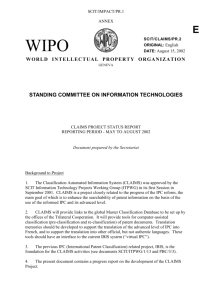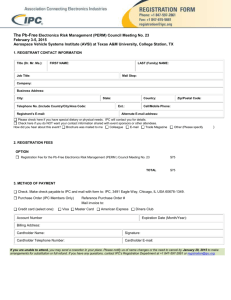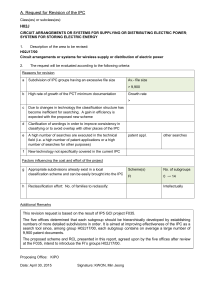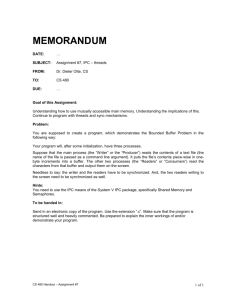CIB - Classification internationale des brevets - Introduction
advertisement
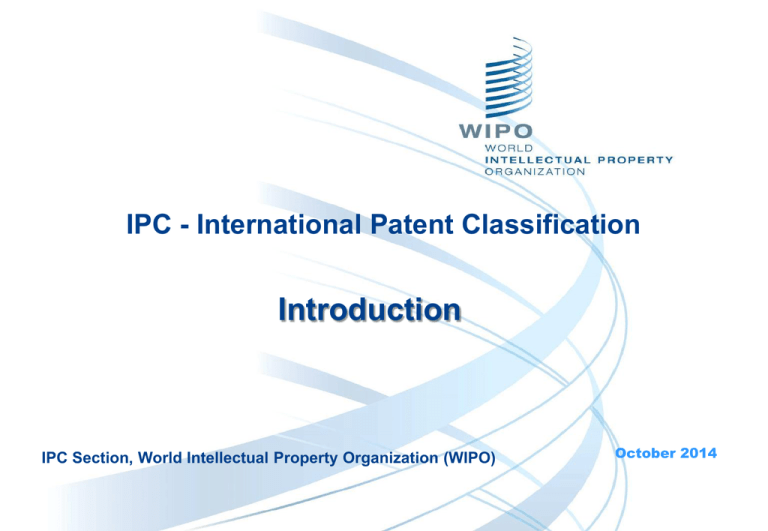
IPC - International Patent Classification Introduction IPC Section, World Intellectual Property Organization (WIPO) October 2014 What is the IPC ? Similar to library classification systems, e.g. Dewey Decimal Classification (DDC) Library of Congress Classification (LCC) Somewhat similar to other classification systems: ICD: International Classification of Diseases (WHO) ISCO: International Standard Classification of Occupations (ILO) CAS registry numbers (Chemical Abstracts Sevice) Nice Classification: International Classification of Goods and Services for the Purposes of the Registrations of Marks Locarno Classification: International Classification for Industrial Designs Vienna Classification: International Classification of the Figurative Elements of Marks (WIPO) 2 What is the IPC ? System for classifying technical subject matter, mainly patent documents Specially adapted for needs of patent documents Applied to >95% of patent documents worldwide Available in most databases for patent search Efficient tool for searching patent documents 3 Purposes of the IPC Primary purposes: effective search tool for the retrieval of patent documents ordering patent documents in order to facilitate access to the technological and legal information Other purposes: selective dissemination of patent information investigation of the state of the art preparation of industrial property statistics 4 What is the IPC ? Large set of symbols/codes (~70000) e.g.: A23G 9/00 Title for each symbol A23G 9/00 Frozen sweets, e.g. ice confectionery, ice-cream; Mixtures therefor "IPC scheme": all symbols and titles + hierarchy + additional elements 5 Symbols presented on front pages of patent documents INID code: Internationally agreed Numbers for the Identification of (bibliographic) Data (ST.9) (50) Technical information *(51) International Patent Classification (ST.10/C) (52) Domestic or National Classification *(54) Title of the invention (56) List of prior art documents (57) Abstract or claim (58) Field of search * Minimum elements on the first page of a patent 6 document (see paragraph 7 of ST.9) Symbols presented in International Search Reports 7 PATENTSCOPE 8 Symbols presented as database contents 9 History of the IPC IPOs handling huge numbers of patent documents were faced with: administrative processing of patent applications; maintenance of search files containing published patent documents; National classification systems created at: the Patent Office of the United States of America in 1831; the German Patent Office in 1877; the United Kingdom Patent Office in 1880. Inclusion of the universal state of the art: Establish concordance tables between two different national classifications; Reclassify foreign patent documents according to its own national classification. Inefficient Need for International Patent Classification system 10 Modern History of the IPC 1952 1968 1971 1975 Council of Europe initiates work on patent classification European Classification of Patents for Invention – 1st edition Diplomatic Conference on the IPC Strasbourg Strasbourg Agreement entered into force New editions of the IPC – every 5 years 2006 8th edition of the IPC – IPC Reform Publication cycle – every 3 years(Core) to 3 months(Advanced) 2009 Yearly publications 2011 IPC Simplification Discontinuation of Advanced/Core levels (full IPC/main group) 2013 IPC Revision Roadmap Identify areas for revision. / Accelerate the publication procedure. 11 Strasbourg Agreement 1975 - Strasbourg Agreement entered into force IPC Union initially 13 members currently 62 member states (as of June 2014) in addition 4 organizations (EPO, EAPO, ARIPO, OAPI) Rights of Member States participate in improving the IPC 12 Strasbourg Agreement Obligation of Member States allot IPC symbols to national published patent documents. Option of classifying in main groups only IPOs that do not have sufficient expertise for classifying to a detailed level have the option to classify in main groups only. IPC applied by more than 100 countries (e.g. 148 PCT members as of June 2014) 13 Bodies of IPC Union Assembly of IPC Union - every two years with WIPO General Assembly Committee of Experts (CE) - once a year - executive body which adopts IPC new versions and general rules (IPC Guide, Guidelines, etc.); - create new revision projects, etc. IPC Revision Working Group (WG) - twice a year - technical body which approves IPC new versions, Definitions, etc. Ad hoc Task Forces - particular tasks, e.g. systematic maintenance, etc. International Bureau (IB) of WIPO - administrative support; - prepare IPC-related meetings and provide secretariat; - preparation of IPC publication; - maintenance of Master Files and IPC-related IT systems, etc. 14 Why use classification? Databases can be searched by keywords, specific terms. More sophisticated approaches, e.g. Natural language search Text mining techniques Advantage of using IPC in comparison to keyword search? 15 Advantages of using IPC Language independent e.g. searching Chinese, Korean, Japanese patent documents (> 50% of weekly publications) often only English abstracts, titles 16 Worldwide Patent Filing Source: IP5 Statistics Report 2012 Edition, p.30 (http://www.fiveipoffices.org/stats/statisticalreports/2012edition.html) 17 Searching Chinese Patent Documents 18 Searching Korean Patent Documents 19 Searching Japanese Patent Documents 20 Advantages of using IPC Terminology / “jargon” independent Scientific literature Patent documents/specifications Patent documents/specifications often written by lawyers: > non-experts: not familiar with specific terminology > prefer generic, unspecific terminology for legal reasons, e.g. to avoid any unnecessary limitation of the scope of protection as defined by claims 21 Examples of “jargon” Swimming pool = “water retaining recreational structure” Balloon = “spherical device filled with gas for recreational purposes” Paper bin = “arrangement for the disposal of refuse” Shoe = “footwear” Helmet = “head protector”, “hardhat”, “headgear”, etc. 22 Advantages of using IPC Terminology / ”jargon” independent Problems with keyword searching: Use of inappropriate terminology, avoiding appropriate terminology Occurring of unwanted/“competing” terminology Variety of options for describing features Different content of different parts of specification 23 Advantages of using IPC Standardized application to documents by experts of patent offices indexing, added value Early classification after application > used for publication (18 months after filing) Reviewed by examiner at examination > classification of granted patents may differ. 24 Advantages of using IPC Concept search: title of classification entry = standardized set of keywords Well defined technical subject matter Stable, i.e. not changing with the times Therefore useful for: - preparing industrial property statistics; - monitoring the progress of technology, patent landscaping: - selective dissemination of information (SDI) in enterprises, 25 Advantages of using IPC Summary Language independent Terminology / ”jargon” independent Standardized application to documents (by experts of patent offices) Available for (old) patent documents where no full text of claims / description is available Concept search More complete search results than pure text search 26 Example Search in PATENTSCOPE all PCT documents with IPC: • Q1: A42B 3/00 (Helmets) 1015 hits Keyword search with: • Q2: “helmet*” • Q3: “headgear*” • Q2 OR Q3 1167 hits 343 hits 1464 hits Q1 AND (Q2 OR Q3) 755 hits 260 755 709 260 documents classified in A42B 3/00 have neither “helmet*” nor “headgear*” in their abstract! Search results by text search include non-relevant information. 27

